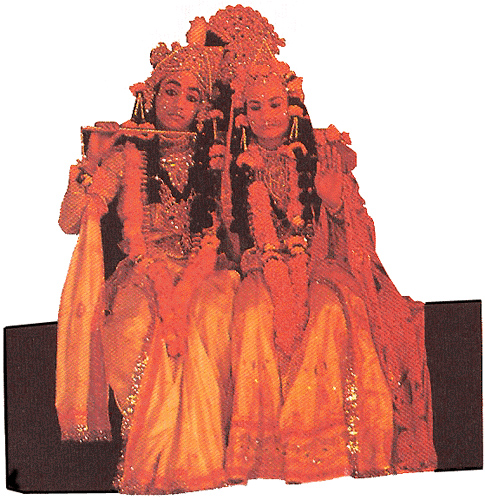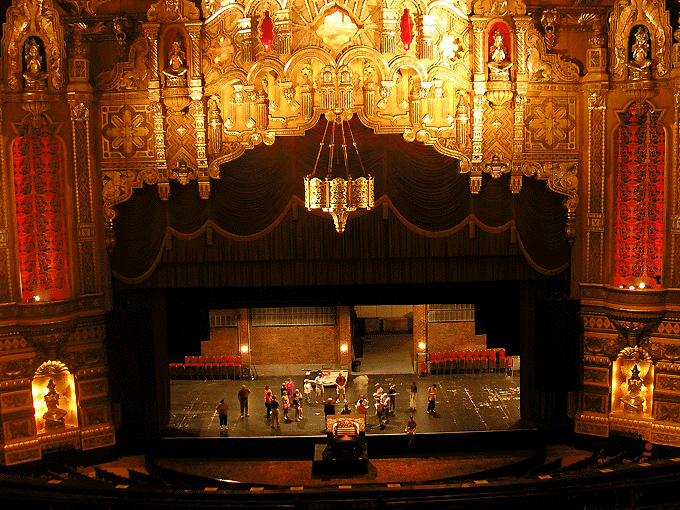Theater in Bengal, Part 2
BY: SUN STAFF

Rasa Lila Drama
Feb 1, CANADA (SUN) — A three-part study of the history of Sanskrit theater in Bengal.
The Modern Period
Translations of Sanskrit play-texts in Bengal continued into the 19th century. A few of these are Krishna Mishra's Prabodhachandrodaya, Kalidasa's Abhijnana-shakuntala (1848) and Ratnavali (1849). Scholars in Bengal composed quite a few Sanskrit texts in the modern period as well. A few examples of these are Amara-mangala by Panchanan Tarkaratna (published c. 1913), Nala-damayantiya and Syamantakoddhar by Kalipada Tarkacharya, etc.
The tradition of Sanskrit theatre significantly influenced the initial phase of Bangla plays. Jogendranath Gupta's Kirtibilas, credited as the first original Bangla play and the first tragedy, makes use of the Nandi, the Sutradhara and Nati. The first Bangla play to be performed on stage, Ramnarayan Tarkaratna's Kulinkulasarvasva (composed in 1854, performed in 1857), also borrows from the Sanskrit tradition in its use of the Nandi, the Sutradhara and the Nati.
With rising interest in social affairs and the effects of western education, the conventions of Sanskrit theatre were seen to be less effective in portraying the social ethos of the period than other forms of drama. Michael Madhusudan Dutt (1824-1873), a well known literary personality of the period, encouraged urban theatre independent of Sanskrit influence by introducing techniques of European dramaturgy. From the mid-19th century onwards, Sanskrit theatre and its derivatives were no longer emphasized in the theatre of Bengal.
Indigenous Theatre
The term 'indigenous theatre' (generally known as 'folk' theatre) encompasses all forms of theatre which originated in the region of Bengal. Unlike the Sanskrit theatre, the indigenous theatre was always in direct contact with the grassroots people and was often created and supported by them. However, it was not closed to the refined techniques of the Sanskrit theatre. In the indigenous theatre, the performers include actors, dancers, singers, musicians, and puppeteers (both male and female). Their performance is not restricted to dialogue in prose but is comprehensive and wide-ranging. It includes any one or more of the following elements: (i) dance, (ii) instrumental music and (iii) speech rendered in prose, verse or lyric, either in the form of narration or that of dialogue. The indigenous theatre of Bangla has developed in distinct forms, which can be loosely categorised into (i) the Narrative, (ii) the Song-and-Dance, (iii) the Processional, and (iv) the Supra-personae.
In the narrative forms of theatre, the lead-narrator (gayen) describes an event, portrays various characters related to the event and enacts the action, all in the third person. While engaged as described above, s/he partly speaks his/her lines in prose, partly recites in verse, and partly sings his/her story. S/he is assisted by the choral singers-cum-musicians (dohars), who employ musical instruments (Mridanga and Mandira) and sing choral passages. The gayen carries a chamar (whisk) in religious performances and occasionally dances while singing. Usually, the performer makes effective use of vocal inflections and physical gestures in his/her portrayal of the characters. Sometimes s/he also readjusts his/her basic costume, and uses a few props to make the portrayal more effective.
The earliest evidence of narrative theatre in Bengal can be traced to the charyapada or charyagiti, a form of songs popular in Bengal from the 9th to the 12th century AD. These songs were composed by Tantric Buddhist mendicants to expound their religious doctrine. They were presented to the lay populace with the help of dance, in a manner similar to the charya dance still seen in Kathmandu Valley, Nepal.
Ethnological studies indicate a long tradition of narrative theatre in the Natha cult. These performances were based on oral compositions of two distinct groups: (i) those dealing with the origin of the Natha siddhas and the subsequent rescue of Minanatha by his disciple Goraksanatha from the enticement of worldly pleasure and (ii) those dealing with the exploits of Queen Maynamati and her son King Govindachandra (or Gopichandra), the disciple of Hadipa. Narrative performances based on the Maynamati-Gopichandra legend were possibly created sometime immediately after the 11th century and gained wide currency all over northern India. On the other hand, the performances based on the Goraksanatha-Minanatha legend are more difficult to date. On the assumption that the Natha cult evolved sometime in the 9th century, it is possible to place the earliest performances of the Goraksanatha-Minanatha legend in the 10th century.
None of the extant literary and liturgical texts of the Dharma cult can be dated beyond the 17th century. However, it is very much possible that in the 12th century, when the cult was definitely in existence, there did exist a body of oral narratives on which the later texts were built. Extant texts and current practice among the followers of the cult indicate that celebrations of the ancient period included narrative performances of oral compositions.
A large number of orally composed folk tales still prevailing at the popular level, such as Madhumalar Kechchha, Sakhisona, Malanchakanyar Kechchha, Shit-Basanta, Kanchanamala and Malatikusumamala, indicate that their original nuclei were created in the 12th century or even earlier. All the tales are secular in content, and some of them are still performed in Bangladesh. It has been only since the first half of the 20th century that they have been scribed and published in editions such as Thakurmar Jhuli. It is reasonable to believe that, for a predominantly non-literate audience, stories would be told rather than read, and the most expedient way to commit a story to memory is to have it composed in verse. Furthermore, terra-cotta plaques depicting secular (Sanskrit Panchatantra) stories have also been discovered in the temple of Somapura Monastery. Therefore, it can be reasonably argued that the secular tales of the ancient period were orally composed in rhymed metrical verse and rendered as narrative performance.
Various political and social factors, including state-patronised Brahmanical hegemony in the 12th century and the advent of the Muslims in the early13th century, caused a qualitative change in the culture of Bengal. Consequently, there was a gradual acculturation, decay and transformation in Buddhist, Dharma and Natha cult performances. On the other hand, an entirely new set of narrative performances appeared in the indigenous theatre of Bengal. Distinguishing between their subject matter, these can be divided into three categories: (1) performances glorifying the Aryan pantheon and heroes of the Ramayana and the Mahabharata, (2) performances glorifying the indigenous pantheon as recounted in the Mangalkavya and (3) performances glorifying Muslim legendary heroes. Besides, the tradition of secular narratives continued as before, invigorated by interaction with the above. In this context, it is important to remember that early Bangla literature was dependent on lyric. Therefore, literary compositions of the period under study should be held as performance-texts, not merely pages of reading material valid only for literary analysis.
Largely based on the Bhagavata, Srikrishnavijay was composed in 1473-80. Therefore, it is very much possible that narrative performance based on oral compositions of Krishna lila existed from earlier times, probably from the beginning of the 13th century. The translation of Valmiki's Ramayana in the first half of the 15th century also presupposes the existence in the 13th and 14th centuries of narrative performances drawing from oral texts based on the exploits of Lord Ramachandra.
Lord Caitanya and Vaisnava Contributions
Initiated in the early 16th century by Chaitanya Mahaprabhu (1486-1533), Gaudiya Vaisnavism made a significant and popular contribution to the theatre of Bengal by giving rise to the narrative form known as Lila Kirtan, which had its formal inception at the famous festival of Kheur in 1576 or slightly after. Narottama Das, who is credited with having given structure to Lila Kirtan, arrived at its structure by stringing together brief Vaisnavite devotional songs known as Padavalis, to produce a coherent narrative based on a particular lila of Radha and Krishna. He synthesised the indigenous musical tradition of Bengal with the north Indian classical tradition and arrived at its unique blend.
From the 16th century onwards, there appear a sizeable number of Mangalakavyas on Manasa, the most important of which was Narayan Dev's Padmapurana (first half of 16th c.) and Ketakadas Ksemananda's Manasamangala (mid-17th c.). Besides existing written texts, quite a few popular versions based on oral compositions also came up during this period. Vijay Gupta's Padmapurana is still performed in south-western Bangladesh as Rayani Gan, while an adaptation of Narayan Dev's text is performed in north Bengal as Padmapurana Gan.
The 16th century is also well known as the era of Mangalakavyas on Chandi, for it was in this period that these gained widest currency. The most renowned Mangalakavya on the goddess is the one composed by Kavikankana Mukundaran Chakravarti (c. 1555-56). The signature-piece (bhanita) indicates that the poet himself performed Chandimangala and parts of it were rendered in lyric. On a few occasions his signature pieces suggest that the poet was in the company of skilled musicians (kalanta, lit. well versed in classical music) and actors (natuya). Another section indicates that the performance was composed of git (song), badya (music), natya (acting) and dance, executed by actors and skilled musicians. This textual evidence proves that Chandimangala was given in the narrative form in the 16th century.
References in Chaitanya Bhagavata (Part I, Chapters 2 & 13; 1535-36) indicate the existence of Mangal Chandir Git (narrative performance based on eulogies of Mangal Chandi), in the first half of the 16th century. The same text also testifies that narrative performances of Shiver Git, based on oral compositions in praise of Shiva, existed in the first half of the 16th century and possibly earlier. A lone performer, who danced and played the damaru (drum) as he sang, would perform in a courtyard.
The appearance of Yusuf-zulekha (c. 1390-1410) marked the entry of an entirely new element, the Perso-Arabic influence, in the history of performance in Bengal. Rasulbijay (1474), which recounts the life of the Prophet, emphasised the keen interest of the Muslims in exerting their distinct identity by attempting to create a tradition parallel to the Hindu Puranas. Both texts were composed under court patronage of the Muslim rulers and point to the beginning of narrative performances based on Islamic root-paradigms. By the 16th century, a large number of texts dealing with Islamic cosmology and legends began to appear in Bengal, and an associated increase in Muslim influenced architecture was also seen throughout the region. While beautiful in their own right, the dramatic, musical, literary and architectural Muslim expressions could not compare, let alone dwarf, the super-excellence of Bengal's own Hindu legacy.

Source: Banglapedia and "History of Bengal"
